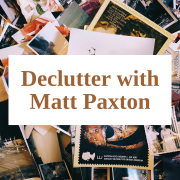Help your downsizing clients create their legacy
Many investment and financial advisors have older clients who struggle with decluttering as they prepare to downsize. I picked up some useful ideas from a session presented by Matt Paxton, the host of the PBS program Legacy List and the author of a book that had the same title as his presentation, Keep the Memories, Lose the Stuff: Declutter, Downsize, and Move Forward with Your Life.
We hold onto things because of the people and the emotions attached to those items, said Paxton. We can’t let go because we love those people and the memories. However, there’s a way to let go of those things while keeping the memories. Paxton said that if you tell their stories, their memory doesn’t die. (However, satisfaction from this process may be hard for some people. An audience member pointed out that not everyone has fond memories of the people in their lives.)
Below is a five-step process suggested by Paxton.
Step 1: Know your finish line.
Know where you are going and your “why.” In Paxton’s case, he wants to be a grandpa, which drives his decluttering.
Write down the real reasons you’re downsizing and put them on the wall everywhere to remind you of your goal.
Step 2: Start small.
Declutter 10 minutes a night for the first two months, then move up to 30 minutes a night. In the first two months, you’re proving to yourself that you can get it done.
Start in a non-emotional area, such as a junk drawer, suggested Paxton. Emphasize “Look at how much did get done” instead of how much is left to do.
Step 3: Focus on your legacy.
Write down a “legacy list” of the top five items in your house. What would you take with you if your house caught fire?
Step 4: Tell the stories.
Tell stories about your top five items. Sharing your stories speeds up the process of letting go of things. The story is the legacy, not the item. Find someone to tell the story to. Your audience could be friends or members of your community—not just family members.
Paxton uses an app called artifcts.com to record stories of items. When you record your stories, don’t get stuck on the details. It doesn’t need to be perfect. Include:
- What is it?
- How did you get it? Who gave it to you?
- What do you remember about that day? What smells and sounds do you remember?
- Why is this item important?
Step 5: Donate.
Paxton recommended donating rather than selling because sales rarely make enough money to make you happy. He estimated that you might receive maybe only 10% of an object’s value.
Paxton said that it’s also helpful to think about “What if someone else needs this now more than I do?” That works for me. I’ve felt touched by the delight with which some Buy Nothing group members have received some of my discards.
Guilt is a huge part of downsizing, Paxton said. But it’s “wasted energy” and represents your brain holding you back from doing the right thing, he added.
You can learn more about Paxton at iammattpaxton.com.
I hope these steps help your clients—and maybe even you—declutter and create a legacy.
Disclosure: If you click on an Amazon link in this post and then buy something, I will receive a small commission. I provide links to books only when I believe they have value for my readers.






